Final report for FNC16-1053
Project Information
Our 6-acre farm overlooks hills and valleys in the Driftless region of Southwest Wisconsin. Between 2014 and 2017 we planted the first 1000 trees of our orchard, and we plan to continue expanding our plantings in the coming years. Our plantings thus far have been largely experimental and include 78 varieties of cider apple trees that we are trying out to determine which trees perform well on our site and which varieties we would like to plant more of in the future. In 2016 we formed Brix Cider LLC and produced our first commercial batches of cider through an arrangement with a local winery, using apples from other local orchards. We anticipate opening our own production facility and cider pub in spring of 2018.
The hard cider industry has experienced a meteoric rise over the last 7 years, and the North Central Region is now home to 180 hard cider producing businesses. The growth in the cider industry provides new markets for growers. In particular it adds value to blemished apples, and it creates new opportunities to explore growing cider specific apple varieties. The fact that cider apples do not need to look good also offers new opportunities for sustainable management as growers may be able to reduce reliance on spraying for certain pests and diseases that only damage fruit cosmetically.
One challenge that regional growers and cider makers face in best advancing the cider industry is a scarcity of information about the cider qualities of specific apple varieties. Having more information about which apples make the best cider will help growers and cider makers alike in determining which varieties to prioritize for future planting and cider production.
To begin to address this challenge, our study evaluated the cider qualities of 40 apple varieties grown in Wisconsin. The varieties were selected from two farms, and they included a mix of common eating apples, heirloom American cider apples, heirloom multi-purpose apples, two English cider apples, and one French cider apple.
Each variety was ground, pressed, and fermented individually in one gallon batches using the same procedures. Juice was tested for each variety to measure brix, pH, titratable acidity, and total tannins. After fermentation, each resulting cider was tasted and evaluated qualitatively to describe the appearance, aroma, flavor, and overall impression.
Our findings suggested the qualities that made a cider desirable were a high brix, moderate acidity, and noticeable tannins, and through our results we are able to see which qualities are present in each variety and what that variety might lend to a blend. Results were compiled into a database and posted on the Brix Cider website.
We conducted several outreach events to share results. These included: a tasting session with other growers, cider makers, and agricultural professionals; a presentation at the SARE Farmers Forum; a presentation at the United States Association of Cider Makers Conference (CiderCon); a farm tour and discussion with agricultural professionals, and a public tasting event and poster at the University of Wisconsin-Madison through cooperation with the Seed to Kitchen Collaborative.
Farmers and cider makers expressed resoundingly positive feedback about the study, and in total, information about the project has reached over 11,000 individuals. We have used the results to prioritize plantings and cider making practices with our own orchard and cider business, and we expect that the others who have accessed project information are using it similarly.
The project objectives we set forth in the grant proposal included the following.
Environmental Benefits:
Growing apples for cider offers growers an opportunity to reduce reliance on pesticides and fungicides due to the fact that cider apples do not require the cosmetic perfection of eating apples. Further, local cider production offers the potential to reduce food miles compared with mass-produced industrial ciders. Increasing knowledge about apples that could be part of a more sustainable cider orchard is a first step towards achieving these environmental benefits. The following two indicators therefore measure the extent to which we succeeded in completing the project and in sharing knowledge with our targeted audience:
- Number of apple varieties with potential for use in environmentally sustainable apple orchards that were collected, photographed, pressed, fermented, tested, and described in detail
- Target of 40 - based on a simple numerical count
- Number of individuals with increased knowledge of cider apple varieties that could be grown in a sustainable orchard
- Total target of 3,330, including:
- 30 from an in-person field day - based on the participant list
- 300 from a poster presentation – based on estimated viewers at the 2017 Cider Conference
- 3000 readers of the project report – based on webpage data in Google Analytics
- Total target of 3,330, including:
Economic Benefits
The burgeoning hard cider industry offers new opportunities for growers and entrepreneurs to increase profits. Existing orchards can explore new market options and diversify their operations for greater economic resilience. Likewise, beginning farmers can tap into new, niche markets through developing pioneering cider-related enterprises. The cider qualities that we are testing are important factors in determining which apple varieties might lead to more profitable cider businesses. Increasing knowledge is a first step towards reaching desired economic benefits, and the following two indicators therefore assess whether we have completed our project and reached our intended audience with information that can be economically beneficial:
- Number of apple varieties with potential to increase orchard profitability that were collected, photographed, pressed, fermented, tested, and described in detail
- Target of 40 - based on a simple numerical count
- Number of individuals with increased knowledge of cider apple varieties that could increase orchard profitability
- Total target of 3,330, including:
- 30 from an in-person field day - based on the participant list
- 300 from a poster presentation – based on estimated viewers at the 2017 Cider Conference
- 3000 readers of the project report – based on webpage data in Google Analytics
- Total target of 3,330, including:
Social Benefits
Advancing artisanal cider offers the social benefit of increasing community connections to locally produced beverages that are part of our national heritage. Artisanal ciders can connect consumers with the rich genetic diversity that is possible with apples while reviving cultural traditions. Increasing knowledge is a first step towards achieving these social benefits. The following two indicators therefore measure the extent to which we succeeded in completing the project and in sharing knowledge with our targeted audience:
- Number of apple varieties with potential to revive cultural traditions that were collected, photographed, pressed, fermented, tested, and described in detail
- Target of 40 - based on a simple numerical count
- Number of individuals with increased knowledge of cider apple varieties that could enhance community connections to locally produced beverages
- Total target of 3,330, including:
- 30 from an in-person field day - based on the participant list
- 300 from a poster presentation – based on estimated viewers at the 2017 Cider Conference
- 3000 readers of the project report – based on webpage data in Google Analytics
- Total target of 3,330, including:
Cooperators
Research
In the fall of 2016, we purchased the majority of project supplies and materials, including fermentation vessels, airlocks, yeast, sanitizer, campden tablets, and other supplies needed for fermenting the ciders. We also purchased all supplies for testing the ciders, including a refractometer, a pH meter, and chemical reagents. Most importantly, we purchased the apples.
The original plan for the project was to source the apples from Seed Savers Exchange orchard, but due to a late frost and some heavy storms, they did not have a harvestable crop this year. As an alternative, we sourced the majority of the apples from Albion Prairie Farm which has a large collection of cider apples. We also purchased additional apple varieties from Appleberry Farm. The resulting apples represented a mix of English and French cider apples, American heirloom cider apples, American heirloom multi-purpose apples, unique local apples, and some common eating apples.
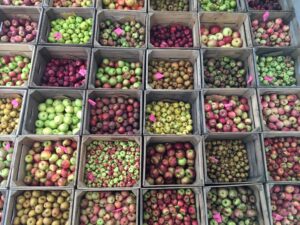
We pressed and fermented all of the apples using the same methods (same yeast, same temperature, same yeast nutrients, etc.) so that any differences in the resulting ciders would be due to the different apples as opposed to differences in the fermentation process. We tested each juice and recorded brix, specific gravity, total acidity, and total tannins. Each of the ciders went through a 3-week primary fermentation followed by a 6-week secondary fermentation. All of the ciders were then bottled and pasteurized.
We then tasted the finished ciders and evaluated them, recording notes on color, aroma, multiple flavor components, and our overall impression. We also conducted a tasting panel with other apple growers, cider makers, and agricultural professionals. We compiled results into a database and posted them online here.
The brix of each cider ranged from 10.5 on the low end to 16.3 on the high end. Generally a high brix level is desired to make a good cider, and anything under 10 would not be desirable. Most of our favorite ciders were those on the higher end of the brix scale, and some of the ciders we found least desirable were on the lower end of the scale. Figure 1 shows the brix measurement for all of the apples.
Figure 1:
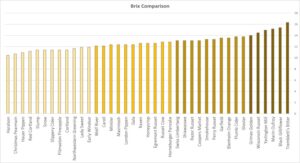
For acidity, most cider makers desire a moderate level (around 6 g/L of Malic acid equivalent), and different apples are typically blended to attain a desired level of acidity. Ciders that we tested ranged from a very low 2.7 g/L total acidity to a very high 11.0 g/L. They therefore offer a range of different blending possibilities. Figure 2 shows the acidity measurements for all of the apples.
Figure 2:
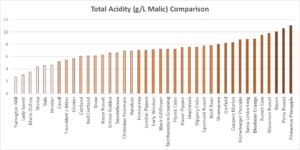
Tannins are highly desired by cider makers, and are typically in low supply in common eating apples. Tannins supply bitterness and astringency that adds flavor complexity and fills out a cider. An apple is considered high in tannins if tannin levels measure at 0.20% or higher. Among the apples we tested, only 4 were high in tannins according to this measure. Several other apples fell between 0.15% and 0.20% and were therefore on the cusp of being high in tannins. In general, we enjoyed the higher tannin apples more than those that were lower in tannins, suggesting that cider makers are correct in pursuing higher tannin apples. For future, similar studies, we believe it would be advantageous to focus on higher tannin apples that growers are currently experimenting with.
Figure 3:
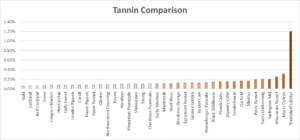
In the qualitative evaluation of each of the ciders, none of the ciders were truly “bad.” There were a few apples that were clear standouts compared with others and made very enjoyable ciders. Some of our favorites included Yarlington Mill, Marin Oufroy, Wisconsin Russet, Black Gilliflower, Plumb Cider, Perry Russet, and Minkler. This gives us some confidence that these may be apples that we would like to grow more of in the future.
Educational & Outreach Activities
Participation Summary:
Our project had a robust outreach approach, and information about the project reached over 11,000 individuals.
Project outreach started with development of the online database for sharing results about the apples that we evaluated. Since posting the database in January, we have had 802 unique visitors to the database webpage according to our website analytics. Most of these viewers also viewed results from multiple apple varieties and/or viewed our blog post about how we conducted the research.
We also shared information about our project and validated our results through a 9 person tasting panel (11 including us) with other local growers, cider makers, and agricultural professionals, including the University of Wisconsin Wine and Cider Outreach Specialist and the Orchard Manager for Seed Savers Exchange. Each participant tasted and evaluated all of the single varietal ciders.
Photo below: Participants in the group tasting panel
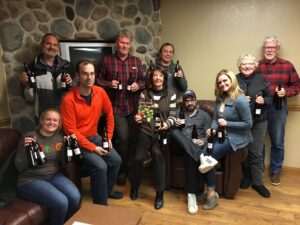
We delivered a presentation at the 2017 SARE Farmers Forum in Illinois which was attended by 14 individuals, and a video recording of the presentation was also posted online here with 33 views at the time of writing.
We delivered a second presentation at the United States Association of Cider Makers Conference (CiderCon) in Chicago. This presentation was attended by 120 individuals. The presentation is available here: Evaluating-Single-Varietals-Presentation. In addition to the formal presentation, participants were given the opportunity to sample the single varietal ciders.
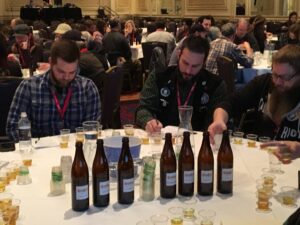
Our project was also featured in the SARE Farmers Forum highlight and this publication goes out to over 10,000 individuals.
In August, 2017 we gave a farm tour to agricultural and extension professionals as part of a SARE Advisory Committee meeting. Five individuals toured our farm, and we discussed this research project.
Also in August of 2017, we participated in a Farm to Flavor event at the University of Wisconsin-Madison in collaboration with the Seed to Kitchen Collaborative. The Seed to Kitchen Collaborative pairs University researchers with farmers and local chefs to evaluate crop varieties for flavor and other characteristics. At the Farm to Flavor event, we shared samples of our single varietal ciders with 220 event participants. We also displayed our Single Varietals Poster.
Learning Outcomes
Through this project, we confirmed our suspicion that some apple varieties produce more desirable ciders than others, and we were able to identify, apple by apple, which characteristics we preferred. At the same time, we learned that many common eating apples also produce an acceptable cider. For our own cider business, this project has informed our decision to make multiple cider lines, including a line of lower cost ciders that are largely made with common eating apples, and a higher end line of ciders that is largely comprised of specialty cider varieties. We have also used the results to prioritize cider-specific varieties that we are grafting and planting out in our orchard.
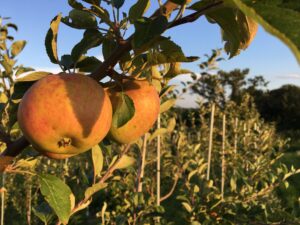
Project Outcomes
We received resoundingly positive feedback regarding this project. A renowned cider maker and educator stated, "Brilliant! Thank you. Glad to see you lend credence to my personal experiments."
Multiple farmers asked about conducting similar trials, and we encouraged them to do so. Our inclusion in the Farmers Forum Highlight also led to us getting interviewed for public radio, and we're always excited to get new publicity for our orchard and cider business!
Testing 40 varieties, as we have done, is really just a start. Many, many more varieties could be similarly evaluated. Parallel research to look at horticultural performance of cider apple varieties would then give a more full picture of which varieties could be socially, environmentally, and economically sustainable.
We're excited for the SARE Partnership Grant that grew out of this project as it will test more apples in collaboration with more farmers for the current harvest season.